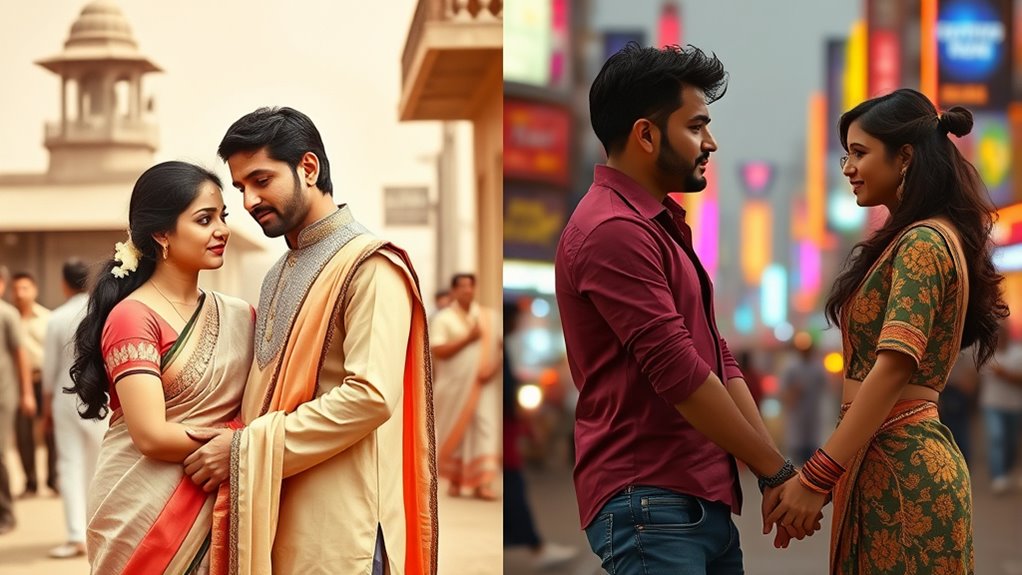Bollywood’s portrayal of romance has evolved from conservative, family-approved love stories rooted in tradition to more bold, inclusive narratives that challenge societal norms. Today, films explore love crossing social, religious, and cultural boundaries, emphasizing self-discovery and emotional vulnerability. Modern storytelling techniques show more realistic and nuanced relationships. If you keep exploring, you’ll see how these changes mirror India’s shifting cultural landscapes and redefine love on screen.
Key Takeaways
- Early Bollywood portrayed love as modest, sacred, and family-approved, emphasizing traditional values and societal expectations.
- The 70s and 80s introduced rebellious, individualistic love stories with complex characters and emotional depth.
- Modern films challenge norms, showcasing love crossing social, religious, and cultural boundaries, emphasizing authenticity and self-discovery.
- Storytelling techniques evolved from song-and-dance routines to realistic portrayals of intimacy, heartbreak, and emotional vulnerability.
- Bollywood’s depiction of romance reflects societal changes, evolving to mirror contemporary relationships and cultural shifts.

Have you ever wondered how Bollywood’s portrayal of romance has evolved over the years? The answer lies in the cultural shifts sweeping through Indian society and the ongoing evolution of storytelling techniques. In the early days, Bollywood romantic films reflected traditional values, emphasizing modesty, sacrifice, and family approval. Love stories centered around arranged marriages or unions that upheld societal expectations, often portraying romance as something sacred and reserved. These movies reinforced cultural norms, with romance depicted as a gentle, almost idealized emotion that fit neatly into the social fabric.
As time progressed, the landscape of Indian society began to shift, and Bollywood’s storytelling adapted accordingly. The 70s and 80s saw the rise of more rebellious, individualistic portrayals of love. Films started exploring themes of personal choice and emotional longing, moving away from purely conservative narratives. This period marked a key point in the cultural shifts that allowed romance to become more expressive and less bound by tradition. The stories grew bolder, reflecting changing attitudes toward love, relationships, and even gender roles. The evolution of storytelling brought in more complex characters and nuanced emotions, making love stories more relatable to the youth and urban audiences.
Fast forward to the recent decades, Bollywood’s depiction of romance has become even more diverse and inclusive. Modern films often challenge traditional notions, showcasing love that crosses social, religious, and cultural boundaries. You now see stories where characters defy familial expectations, pursue their hearts, and navigate complex societal pressures. The influence of global cinema and the digital age has also introduced a more frank and realistic portrayal of love, intimacy, and heartbreak. Today’s Bollywood romances are less idealized and more authentic, reflecting the realities of contemporary relationships. They embrace themes like friendship, self-discovery, and emotional vulnerability, resonating with a younger, more progressive audience. Additionally, the rise of diverse storytelling styles and the incorporation of modern cinematic techniques have further enriched the portrayal of love on screen.
Throughout this journey, the evolution of storytelling has played a crucial role in shaping how love is depicted on screen. From song-and-dance routines to subtle glances, Bollywood’s romantic narratives have continuously adapted to mirror the shifting cultural landscape. What remains consistent is Bollywood’s ability to capture the universal essence of love—its joys, struggles, and complexities—while evolving to stay relevant. As society continues to change, so will the stories that define Bollywood romance, making it a mirror of India’s ongoing cultural transformation.
Frequently Asked Questions
How Have Bollywood Romance Themes Influenced Indian Societal Norms?
You see that Bollywood romance themes have shaped societal perceptions by challenging traditional gender expectations and promoting love beyond caste and class barriers. As you watch these films, you might notice a shift towards more egalitarian relationships, encouraging individuals to question societal norms. This influence fosters greater acceptance of diverse love stories, gradually transforming Indian society’s views on gender roles and romantic relationships, making them more inclusive and open-minded.
What Role Do Regional Languages Play in Romantic Bollywood Films?
Did you know that over 1,600 regional dialects are spoken in India? In romantic Bollywood films, regional languages play a crucial role by adding authenticity and emotional depth. They help connect characters and audiences through language diversity, making love stories more relatable and heartfelt. Using regional dialects enriches the narrative, reflecting India’s cultural mosaic and celebrating its linguistic variety, ultimately enhancing the film’s emotional impact.
How Has Technology Impacted Romantic Storytelling in Bollywood?
Technology has transformed romantic storytelling in Bollywood by enabling virtual intimacy and enhancing digital storytelling. You can now experience love stories through social media, video calls, and immersive visuals, making emotions more immediate and relatable. This shift allows filmmakers to explore new narrative techniques, deepening characters’ connections and engaging audiences more personally. As a result, love stories feel more authentic, dynamic, and accessible in the digital age.
Are There Differences in Romance Portrayal Between Male and Female Leads?
Isn’t it striking how Bollywood often paints romance differently for men and women? You’ll notice gender stereotypes influencing these portrayals; men are depicted as stoic heroes, while women often show heightened emotional expression. This creates a romantic dynamic rooted in traditional roles. While modern films challenge these norms, the contrast still highlights how gender stereotypes shape romantic portrayals, making love stories feel both familiar and evolving.
How Do Bollywood Romantic Movies Compare Internationally Over Time?
You’ll notice that Bollywood romantic movies have evolved internationally by embracing diverse cultural differences and blending traditional narrative styles with modern storytelling. Over time, these films have gained global appeal, showcasing universal themes of love while respecting cultural nuances. This mix helps Bollywood connect with audiences worldwide, making its romantic depictions more relatable and innovative, and allowing it to stand out in the international film landscape.
Conclusion
As you watch Bollywood’s love stories evolve, you see how the genre blooms like a garden, blending tradition with modern hues. The passion once painted in bold, sweeping strokes now dances in subtle, intricate details. Just as seasons change, so does romance—sometimes fiery, sometimes gentle. You’re invited to savor this journey, where every era’s story adds a new color to the vibrant tapestry of love, reminding you that true romance is forever in motion.









